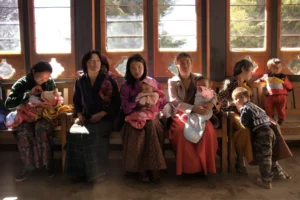Bhutan achieves landmark reduction in maternal and child mortality
Bhutan has achieved a new milestone in maternal and child health with a dramatic decline in both maternal and child mortality rates, according to the National Health Survey (NHS) 2023.
The maternal mortality ratio (MMR) dropped from 86 to 53 per 100,000 live births between 2012 and 2023 while the percentage of institutional deliveries increased from 73.7 to 98, indicating an increased reliance on health facilities for childbirth.
The NHS 2023 also reported that 81.1 percent of newborns are now receiving skin-to-skin contact with their mothers immediately after birth—a practice known as kangaroo care.
This method is pivotal in developing maternal-infant bonding and enhancing the newborn’s health by stabilising body temperature, heartbeat, and other vital functions. Kangaroo care also boosts breastfeeding and helps reduce postpartum bleeding in mothers.
Child mortality rates have also seen a dramatic decline. The neonatal mortality rate, which measures deaths within the first month of life per 1,000 live births, fell from 21 in 2012 to 6.9 in 2023.
Similarly, the infant mortality rate, representing deaths before age one per 1,000 live births, decreased from 30 to 15.2. The under-five mortality rate, indicating deaths before age five per 1,000 live births, also halved from 37.3 to 19.5.The percentage of births attended by skilled health workers increased from 74.6 percent to 98.5 percent over the same period. This significant improvement reflects the country’s commitment to enhancing healthcare delivery and ensuring that more births are managed by trained professionals.
The officials from the Ministry of Health (MoH) attributed the noteworthy decrease in mother and child death to the dedicated efforts of health workers and widespread support.
Officials said that it also portrays Bhutan’s robust initiatives such as in antenatal care, contraceptives, immunisation, emergency obstetric and newborn care, and accelerating maternal and child health outcomes project, among others.
Since 2005, MoH has aimed to ensure 100 percent institutional delivery, a goal that has substantially contributed to the decline in mortality rates. Social factors, such as improved road connectivity, higher education levels, and economic development, have also supported this success.
The ministry aims to achieve zero maternal and child deaths, and towards this end, health officials said existing facilities would be strengthened further.
The main challenge is reaching remote highland communities where access to health centres is limited.
The World Health Organisation (WHO) officials said that WHO has been playing a catalytic role to reduce mother and child deaths and affirmed their continued support in providing technical assistance and guidance to the MoH.
Globally, Target 3.1 of the 2030 Sustainable Development Goals (SDGs) aims to reduce the maternal mortality rate to less than 70 per 100,000 live births. Bhutan has successfully met this target. In contrast, the global MMR was estimated at 223 per 100,000 live births in 2020, down from 339 in 2000.
According to WHO, about 287,000 women died during and following pregnancy and childbirth in 2020, where 95 percent of deaths occurred in low and lower middle-income countries and most could have been prevented.
Many of these deaths were preventable through adequate antenatal and postnatal care.
Since 1990, the global under-five mortality rate has decreased by 59 percent, from 93 deaths per 1,000 live births to 37 in 2022. In addition, globally, neonatal deaths have fallen from 5.2 million in 1990 to 2.3 million in 2022.





